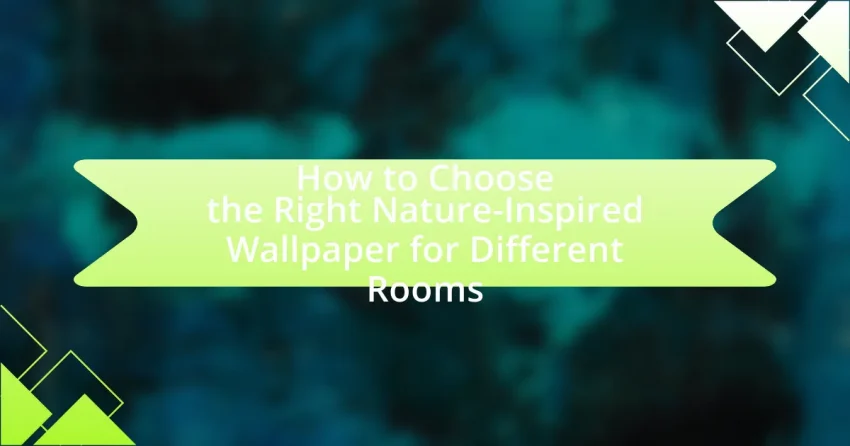Nature-inspired wallpaper is a wall covering that incorporates designs and patterns derived from natural elements, such as plants, animals, and landscapes, to create a calming atmosphere in interior spaces. This article explores the differences between nature-inspired and traditional wallpaper, common themes, and the psychological benefits of incorporating natural imagery into home decor. It provides guidance on selecting appropriate wallpaper for various rooms, considering factors like room function, size, and lighting, while also discussing installation best practices and maintenance tips. Additionally, the article highlights current trends and innovative materials in the wallpaper industry, emphasizing the importance of sustainability and biophilic design.

What is Nature-Inspired Wallpaper?
Nature-inspired wallpaper is a type of wall covering that features designs and patterns derived from natural elements such as plants, animals, landscapes, and organic textures. This style aims to bring the essence of the outdoors into interior spaces, creating a calming and refreshing atmosphere. The popularity of nature-inspired wallpaper has been supported by trends in biophilic design, which emphasizes the connection between humans and nature, enhancing well-being and aesthetic appeal in living environments.
How does nature-inspired wallpaper differ from traditional wallpaper?
Nature-inspired wallpaper differs from traditional wallpaper primarily in its design elements, which often feature natural motifs such as plants, animals, and landscapes, creating a more organic and serene atmosphere. Traditional wallpaper typically includes geometric patterns or solid colors that do not evoke the same connection to nature. The use of nature-inspired designs can enhance the ambiance of a room by promoting relaxation and well-being, as supported by studies indicating that natural imagery can reduce stress and improve mood.
What themes are commonly found in nature-inspired wallpaper?
Common themes found in nature-inspired wallpaper include botanical designs, landscapes, animal motifs, and natural textures. Botanical designs often feature floral patterns and greenery, reflecting the diversity of plant life. Landscapes capture scenic views such as mountains, forests, and oceans, bringing the outdoors inside. Animal motifs showcase wildlife, from birds to insects, adding a dynamic element to the decor. Natural textures mimic materials like wood, stone, or water, enhancing the organic feel of the space. These themes are popular because they create a calming atmosphere and connect interior spaces with the natural world.
How do colors and patterns reflect natural elements?
Colors and patterns reflect natural elements by mimicking the hues and textures found in nature, such as the greens of forests, the blues of oceans, and the earthy tones of soil. For instance, wallpapers that feature botanical prints often use vibrant greens and floral patterns to evoke the essence of a garden, while designs inspired by water may incorporate shades of blue and flowing patterns that resemble waves. This connection is supported by studies showing that color psychology influences mood and perception, with natural colors promoting calmness and relaxation, making them ideal for spaces like bedrooms and living rooms.
Why choose nature-inspired wallpaper for your home?
Choosing nature-inspired wallpaper for your home enhances the aesthetic appeal and promotes a calming atmosphere. This type of wallpaper often features designs that reflect natural elements such as plants, landscapes, and wildlife, which can create a serene environment that reduces stress and improves well-being. Studies have shown that exposure to nature, even through visual representations, can lead to increased feelings of relaxation and happiness. For instance, research published in the Journal of Environmental Psychology indicates that nature imagery can significantly lower stress levels and enhance mood. Thus, incorporating nature-inspired wallpaper not only beautifies your space but also contributes positively to your mental health.
What psychological benefits does nature-inspired decor provide?
Nature-inspired decor provides psychological benefits such as reduced stress, enhanced mood, and improved cognitive function. Research indicates that exposure to natural elements can lower cortisol levels, which are associated with stress, and promote feelings of relaxation and well-being. A study published in the Journal of Environmental Psychology found that individuals exposed to nature-themed environments reported higher levels of happiness and lower levels of anxiety. Additionally, nature-inspired decor can stimulate creativity and focus, as evidenced by findings from the University of Michigan, which suggest that interaction with nature can improve attention span and cognitive performance.
How can nature-inspired wallpaper enhance the aesthetic of a room?
Nature-inspired wallpaper enhances the aesthetic of a room by introducing organic patterns and colors that evoke a sense of tranquility and connection to the outdoors. This type of wallpaper can create a calming atmosphere, as studies show that natural elements in interior design can reduce stress and promote well-being. For instance, a study published in the Journal of Environmental Psychology found that exposure to nature-themed decor can improve mood and cognitive function. By incorporating elements like floral designs, forest scenes, or botanical prints, nature-inspired wallpaper can transform a space, making it feel more inviting and harmonious.

How to Select Nature-Inspired Wallpaper for Different Rooms?
To select nature-inspired wallpaper for different rooms, first consider the room’s purpose and ambiance. For example, in a living room, opt for designs that evoke tranquility, such as soft floral patterns or serene landscapes, which can create a welcoming atmosphere. In bedrooms, choose wallpapers with calming colors and nature motifs, like trees or gentle waves, to promote relaxation and restfulness. For kitchens, vibrant fruit or herb patterns can add energy and freshness, while in bathrooms, aquatic themes or botanical prints can enhance a spa-like feel.
Research indicates that nature-inspired designs can positively affect mood and well-being, making them suitable for various environments. A study published in the Journal of Environmental Psychology found that exposure to nature imagery can reduce stress and improve cognitive function, supporting the choice of such wallpapers in personal spaces.
What factors should you consider when choosing wallpaper for a specific room?
When choosing wallpaper for a specific room, consider the room’s purpose, lighting, size, and existing decor. The room’s purpose influences the mood; for example, calming colors are suitable for bedrooms, while vibrant patterns may work well in playrooms. Lighting affects how colors appear; natural light can brighten hues, while artificial light may alter their perception. The room’s size is crucial; smaller rooms benefit from lighter colors to create an illusion of space, while larger rooms can accommodate bolder designs. Lastly, the existing decor should harmonize with the wallpaper to ensure a cohesive aesthetic.
How do room size and lighting affect wallpaper selection?
Room size and lighting significantly influence wallpaper selection by determining the visual impact and ambiance of a space. Larger rooms can accommodate bold patterns and darker colors, which can create a dramatic effect, while smaller rooms benefit from lighter colors and smaller patterns to enhance the sense of space. Additionally, natural and artificial lighting affects how colors appear; for instance, bright lighting can wash out colors, making softer hues more suitable, whereas dim lighting may require richer tones to maintain visual interest. Studies indicate that color perception changes under different lighting conditions, reinforcing the need to consider both room size and lighting when selecting wallpaper to achieve the desired aesthetic and functionality.
What role does the room’s function play in wallpaper choice?
The room’s function significantly influences wallpaper choice by dictating the desired atmosphere and durability requirements. For instance, a living room may benefit from vibrant, inviting patterns that promote relaxation and social interaction, while a bathroom requires moisture-resistant materials with simpler designs to withstand humidity. Research indicates that specific colors and patterns can affect mood and behavior, supporting the idea that wallpaper selection should align with the intended use of the space.
How can you match wallpaper styles with room themes?
To match wallpaper styles with room themes, first identify the overall theme of the room, such as modern, rustic, or traditional. For example, a modern theme may benefit from geometric or abstract wallpaper, while a rustic theme could be complemented by floral or nature-inspired designs. The color palette of the wallpaper should also align with the room’s existing colors to create a cohesive look. Research indicates that harmonious color schemes enhance the aesthetic appeal of a space, as supported by studies in interior design psychology. Therefore, selecting wallpaper that reflects the room’s theme and color scheme ensures a visually pleasing environment.
What types of nature-inspired wallpaper work best in living rooms?
Nature-inspired wallpapers that work best in living rooms include botanical prints, landscapes, and textured designs that mimic natural elements. Botanical prints, featuring leaves and flowers, create a fresh and vibrant atmosphere, while landscape wallpapers depicting serene scenes can enhance the sense of space and tranquility. Textured designs, such as those resembling wood or stone, add depth and warmth to the living room environment. These types of wallpapers not only reflect nature but also contribute to a calming and inviting ambiance, making them ideal choices for living spaces.
Which designs are suitable for bedrooms and why?
Nature-inspired designs such as floral patterns, serene landscapes, and soft botanical motifs are suitable for bedrooms because they promote relaxation and tranquility. Floral patterns can create a calming atmosphere, while serene landscapes evoke a sense of peace, contributing to a restful environment. Soft botanical motifs, with their gentle colors and organic shapes, enhance the connection to nature, which has been shown to reduce stress and improve overall well-being. Studies indicate that exposure to nature-inspired elements can lead to better sleep quality and lower anxiety levels, making these designs particularly effective for bedroom settings.

What are the Best Practices for Installing Nature-Inspired Wallpaper?
The best practices for installing nature-inspired wallpaper include preparing the wall surface, measuring and cutting the wallpaper accurately, applying adhesive evenly, and ensuring proper alignment during installation. Preparing the wall involves cleaning and priming to create a smooth surface, which enhances adhesion and prevents bubbling. Accurate measurement and cutting are crucial to avoid waste and ensure a seamless look; using a straight edge and sharp utility knife can help achieve clean cuts. Applying adhesive evenly prevents uneven surfaces and ensures the wallpaper adheres properly. During installation, aligning the wallpaper with a level line is essential to maintain a straight pattern, especially with nature-inspired designs that often feature repeating elements. Following these practices leads to a professional finish and enhances the aesthetic appeal of the space.
How do you prepare a room for wallpaper installation?
To prepare a room for wallpaper installation, first, clear the space by removing furniture and covering the floor with a drop cloth. This step ensures that the area is free from obstructions and protects surfaces from damage. Next, clean the walls thoroughly to remove dust, grease, and old adhesive, as a clean surface is essential for proper adhesion of the wallpaper. After cleaning, repair any holes or imperfections in the walls with spackle or joint compound, and sand the surface smooth once dry. Finally, measure the walls and cut the wallpaper to size, ensuring that patterns align correctly. These preparation steps are crucial for achieving a professional-looking finish and ensuring the longevity of the wallpaper.
What tools and materials are necessary for a successful installation?
For a successful installation of nature-inspired wallpaper, essential tools and materials include a utility knife, wallpaper paste, a smoothing tool, a measuring tape, a level, and a straight edge. The utility knife is necessary for precise cutting of the wallpaper, while wallpaper paste ensures proper adhesion to the wall surface. A smoothing tool helps eliminate air bubbles during application, and a measuring tape is crucial for accurate measurements of wall dimensions. A level ensures that the wallpaper is applied straight, and a straight edge aids in making clean cuts. These tools and materials are standard in wallpaper installation, as confirmed by industry guidelines and expert recommendations.
How can you ensure a smooth application process?
To ensure a smooth application process for nature-inspired wallpaper, prepare the wall surface by cleaning and repairing any imperfections. A clean, smooth surface allows for better adhesion and a more professional finish. According to the Wallcoverings Association, proper wall preparation can significantly reduce the likelihood of bubbles and peeling, which are common issues during wallpaper application. Additionally, using the right adhesive for the specific wallpaper type enhances durability and ease of application, further contributing to a seamless process.
What maintenance tips should you follow for nature-inspired wallpaper?
To maintain nature-inspired wallpaper, regularly dust it with a soft, dry cloth to prevent dirt buildup. Additionally, clean any stains promptly using a damp cloth with mild soap, ensuring not to saturate the wallpaper, as excessive moisture can damage it. For longevity, avoid placing the wallpaper in direct sunlight, which can cause fading, and ensure the room has proper humidity levels to prevent peeling. These practices help preserve the aesthetic and integrity of the wallpaper, ensuring it remains vibrant and intact over time.
How do you clean and care for different types of wallpaper?
To clean and care for different types of wallpaper, first identify the wallpaper type: vinyl, paper, or fabric. Vinyl wallpaper can be wiped down with a damp cloth and mild soap, as it is water-resistant. Paper wallpaper requires a gentler approach; use a dry cloth or a soft brush to remove dust, and avoid moisture to prevent damage. Fabric wallpaper should be vacuumed with a brush attachment to remove dust, and spot cleaning with a damp cloth is recommended for stains, ensuring not to saturate the fabric. These methods are effective because they align with the material properties of each wallpaper type, preventing deterioration while maintaining appearance.
What should you do if your wallpaper gets damaged?
If your wallpaper gets damaged, you should assess the extent of the damage and determine whether it can be repaired or needs to be replaced. Minor tears or scratches can often be fixed with wallpaper adhesive or a patch, while significant damage may require removing the affected section and replacing it with a matching piece. According to the National Guild of Professional Paperhangers, proper repair techniques can restore the appearance of wallpaper effectively, ensuring that the aesthetic of the room remains intact.
What are some common mistakes to avoid when choosing nature-inspired wallpaper?
Common mistakes to avoid when choosing nature-inspired wallpaper include selecting patterns that are too busy, which can overwhelm a space, and failing to consider the room’s lighting, as natural light can significantly alter the appearance of colors and patterns. Additionally, neglecting to match the wallpaper style with the room’s overall decor can create a disjointed look. It’s also important to avoid choosing materials that are not suitable for the room’s humidity levels, such as using paper wallpaper in a bathroom. Lastly, overlooking the scale of the pattern can lead to a mismatch with the room’s size, where large patterns can dominate small spaces, while small patterns may get lost in larger rooms.
How can you avoid clashing patterns and colors?
To avoid clashing patterns and colors, select a cohesive color palette and limit the number of different patterns used in a single space. A cohesive color palette ensures that all elements harmonize, while using a maximum of two to three patterns prevents visual chaos. For instance, pairing a bold floral wallpaper with a subtle geometric design can create balance, as long as the colors in both patterns complement each other. This approach is supported by design principles that emphasize unity and contrast, which enhance the overall aesthetic without overwhelming the viewer.
What should you consider regarding longevity and durability?
When considering longevity and durability in nature-inspired wallpaper, focus on material quality and resistance to wear. High-quality wallpapers made from vinyl or non-woven materials typically offer better durability, as they are more resistant to moisture, fading, and tearing compared to paper-based options. For instance, vinyl wallpapers can withstand cleaning and are less likely to peel in humid environments, making them suitable for kitchens and bathrooms. Additionally, look for wallpapers with a high washability rating, which indicates their ability to endure cleaning without damage. This ensures that the wallpaper maintains its appearance over time, providing a lasting aesthetic in your space.
What are the latest trends in nature-inspired wallpaper?
The latest trends in nature-inspired wallpaper include the use of bold botanical prints, textured surfaces that mimic natural materials, and eco-friendly inks and substrates. Bold botanical prints, featuring oversized leaves and flowers, create a striking focal point in any room, while textured wallpapers that resemble wood, stone, or fabric add depth and warmth to interiors. Additionally, the growing demand for sustainability has led to an increase in wallpapers made from recycled materials and printed with non-toxic inks, appealing to environmentally conscious consumers. These trends reflect a broader movement towards biophilic design, which emphasizes the connection between indoor spaces and the natural environment.
How are modern designs evolving in the wallpaper industry?
Modern designs in the wallpaper industry are evolving towards sustainability, innovative materials, and digital printing technologies. This shift is driven by consumer demand for eco-friendly options, with many manufacturers now using recycled materials and non-toxic inks. Additionally, advancements in digital printing allow for greater customization and intricate designs, enabling consumers to create unique, nature-inspired patterns that reflect personal style. The trend towards biophilic design, which emphasizes a connection to nature, is also influencing wallpaper aesthetics, leading to an increase in botanical prints and natural textures.
What innovative materials are being used in nature-inspired wallpaper?
Innovative materials used in nature-inspired wallpaper include eco-friendly substrates like recycled paper, natural fibers such as bamboo and jute, and biodegradable inks. These materials not only mimic natural textures and patterns but also promote sustainability. For instance, wallpapers made from recycled paper reduce waste and energy consumption, while natural fibers provide a tactile quality that enhances the aesthetic appeal. Biodegradable inks ensure that the printing process is environmentally friendly, aligning with the overall theme of nature-inspired design.
What tips can help you choose the right nature-inspired wallpaper for your home?
To choose the right nature-inspired wallpaper for your home, consider the room’s purpose, color scheme, and lighting. Selecting wallpaper that complements the function of the room enhances the overall atmosphere; for example, calming designs work well in bedrooms, while vibrant patterns can energize living spaces. Additionally, ensure the wallpaper’s colors harmonize with existing decor to create a cohesive look. Natural light affects how colors appear, so test samples in different lighting conditions to see how they change throughout the day. Finally, consider the scale of the pattern; larger designs can make a bold statement in spacious areas, while smaller patterns may suit more intimate spaces.
